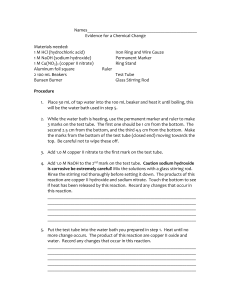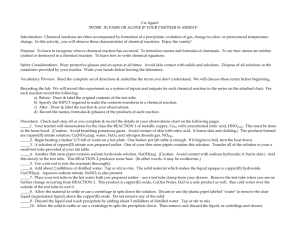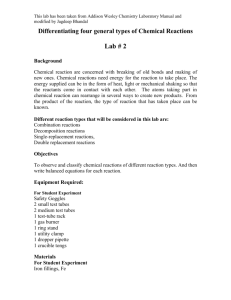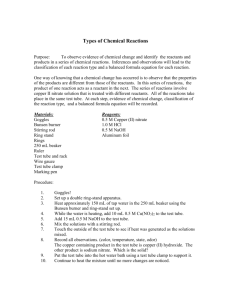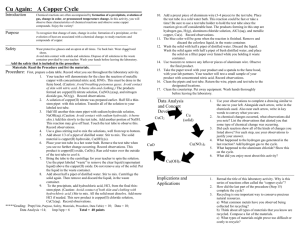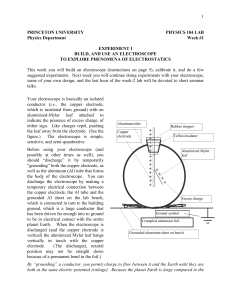Cu Again: A Copper Cycle Lab
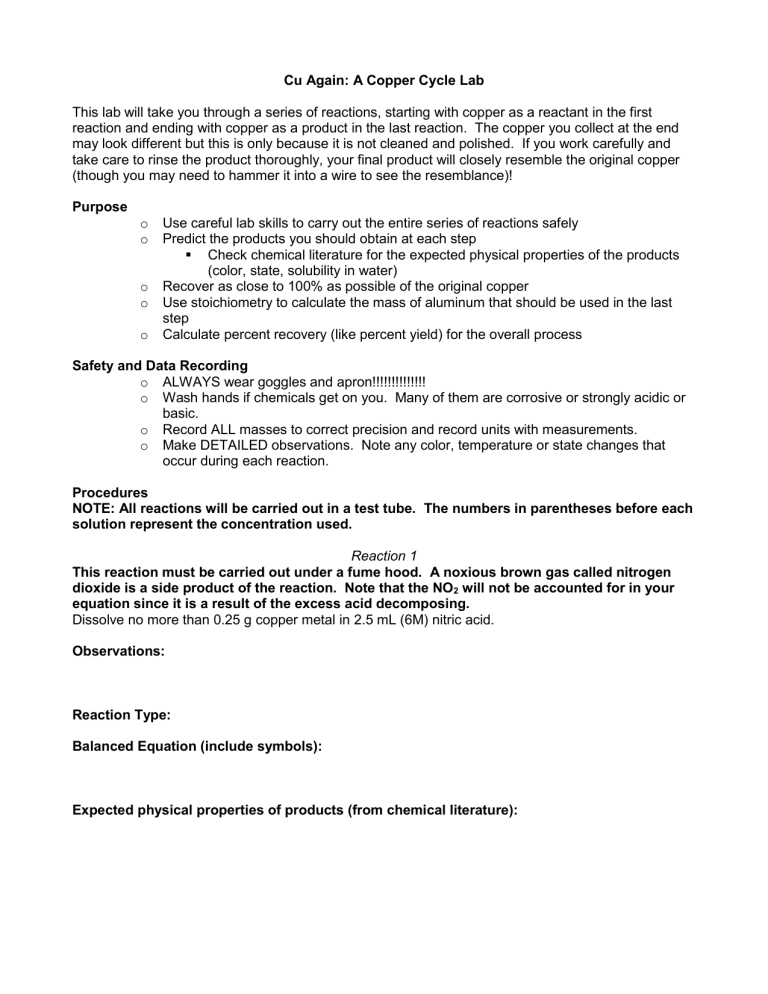
Cu Again: A Copper Cycle Lab
This lab will take you through a series of reactions, starting with copper as a reactant in the first reaction and ending with copper as a product in the last reaction. The copper you collect at the end may look different but this is only because it is not cleaned and polished. If you work carefully and take care to rinse the product thoroughly, your final product will closely resemble the original copper
(though you may need to hammer it into a wire to see the resemblance)!
Purpose o Use careful lab skills to carry out the entire series of reactions safely o Predict the products you should obtain at each step
Check chemical literature for the expected physical properties of the products
(color, state, solubility in water) o Recover as close to 100% as possible of the original copper o Use stoichiometry to calculate the mass of aluminum that should be used in the last step o Calculate percent recovery (like percent yield) for the overall process
Safety and Data Recording o ALWAYS wear goggles and apron!!!!!!!!!!!!!! o Wash hands if chemicals get on you. Many of them are corrosive or strongly acidic or basic. o Record ALL masses to correct precision and record units with measurements. o Make DETAILED observations. Note any color, temperature or state changes that occur during each reaction.
Procedures
NOTE: All reactions will be carried out in a test tube. The numbers in parentheses before each solution represent the concentration used.
Reaction 1
This reaction must be carried out under a fume hood. A noxious brown gas called nitrogen dioxide is a side product of the reaction. Note that the NO
2
will not be accounted for in your equation since it is a result of the excess acid decomposing.
Dissolve no more than 0.25 g copper metal in 2.5 mL (6M) nitric acid.
Observations:
Reaction Type:
Balanced Equation (include symbols):
Expected physical properties of products (from chemical literature):
Reaction 2
The non-gaseous product from Reaction 1 is the first reactant for this reaction.
To the product solution, add 1.5 mL (6M) sodium hydroxide. DO NOT MIX!!
Observations:
Reaction Type:
Balanced Equation (include symbols):
Expected physical properties of products (from chemical literature):
Reaction 3
If the test tube is not ½ full, add distilled water until it is. This water is NOT a reactant. ONLY the copper compound formed in Reaction 2 will be a reactant for this reaction. The other compound and water are bystanders and will be rinsed away at the end of this step.
Clamp the test tube in a hot water bath, submerging it as low as possible without letting the bottom touch the beaker. Heat and watch for changes. When the change is nearly complete, stir with a glass stirring rod until the change is complete. Remove the test tube and cool it by running the outside under cold water. Allow the contents to settle, then carefully pipette as much of the clear solution as possible away from the test tube (the clear solution contains the extra bystander solution to be discarded).
*Unplug the hotplate, but do not remove the water (in case you need it during the last step).*
Observations:
Why would it be difficult to separate out the bystander solution at this step?
Reaction Type (remember, only one reactant!):
Balanced Equation (include symbols):
Expected physical properties of products (from chemical literature):
Reaction 4
To the remaining solid product, slowly add (6M) hydrochloric acid until all of the solid disappears. Do not add excess acid once the reaction is complete.
Observations:
Reaction Type:
Balanced Equation (include symbols):
Expected physical properties of products (from chemical literature):
Reaction 5
ONLY the copper compound formed above will react with the added reactant in this step. If the test tube is not approx. ¾ full, add distilled water until it is. Water is not a reactant, it is only diluting the solution.
Obtain a piece of Aluminum wire and record its mass. Place the aluminum in the solution and gently mix. The reaction is complete when the solution is colorless. (Bubbling may still be present due to a side reaction.) ONLY if this reaction is proceeding slowly, you may clamp the test tube in the warm water left over from Reaction 3.
Observations:
Reaction Type:
Balanced Equation (include symbols):
Expected physical properties of products (from chemical literature):
Recovery of Product
Carefully decant (pour off) the liquid into a beaker. Make sure to keep the solid product in the test tube at all times. Once you have successfully separated any liquid from the solid, the liquid may be discarded. Use a metal scoop to scrape all of the brown solid from the extra aluminum wire into the test tube. Rinse and scrape the aluminum until as much of the brownish solid as possible is left in the test tube. Set the aluminum aside.
Cleaning of Product
Add about 10 mL of distilled water to the solid in the test tube. Stir and allow the solid to settle.
Decant the water from the test tube into a beaker. This p rocess is called “washing”. Wash the product 1-2 more times then scrape it onto a piece of pre-weighed filter paper to dry overnight. (Mark your name on the filter paper in pencil .) Once dry, record the mass of the copper product.
Analyze Aluminum
Clean the remaining aluminum wire from Reaction 5 with a test tube brush. Dry and record the new mass of aluminum. Return the aluminum and any other left over chemicals to the teacher.
Make sure to clean all lab equipment with soap and water and wash your hands. Make sure the hot plate is cooled before returning it to the cabinet. DO NOT TAKE OFF YOUR GOGGLES
UNTIL ALL CHEMICALS ARE PUT AWAY AND ALL GLASSWARE IS WASHED AND DRIED.
DATA REPORTING AND ANALYSIS
1. On a separate piece of paper, create an organized data table to show your results.
2. Calculate the percent recovery of the overall process (just like percent yield). Explain where the numbers came from.
3. Use the calculated percent recovery and experimental observations to comment on the accuracy of the processes used. Describe at least one error SPECIFIC to this experiment that could account for YOUR discrepancy (you probably did not get a perfectly clean 100% yield).
4. For this question, we’ll assume all the copper atoms from the beginning were still present in the last step. Calculate the number of moles of copper you started with.
Moles Cu
Verify that the # moles of copper from Reaction 1 equals the # moles of copper (II) chloride in
Reaction 5. Then, write the balanced equation for Reaction 5. Using stoichiometry, determine the moles, then mass of aluminum that should have been consumed in this step. Account for any discrepancies in your experimental data.


